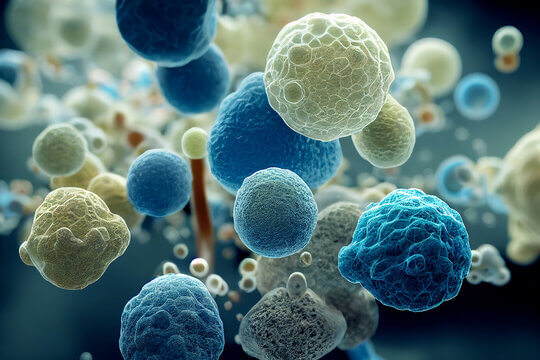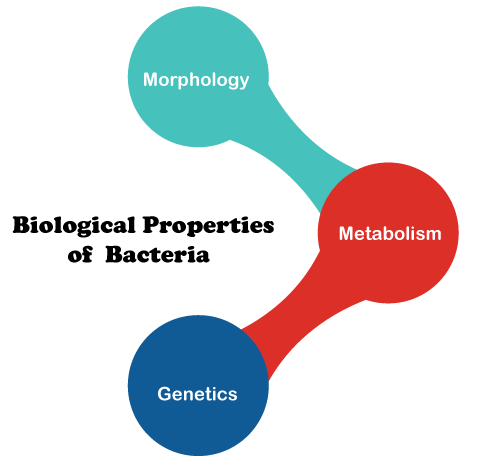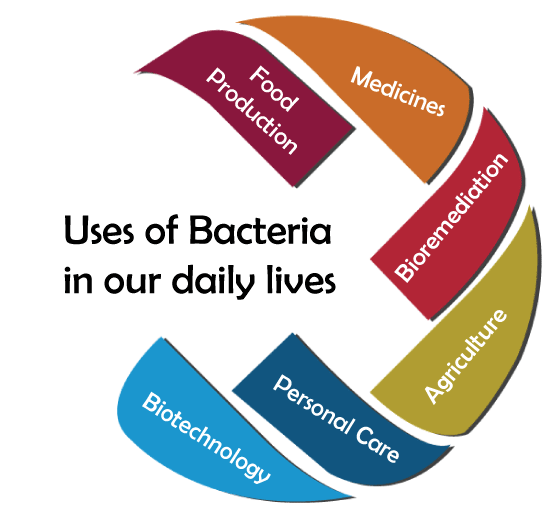Bacteria DefinitionBacteria are single-celled microorganisms that are found virtually everywhere on Earth. They are found in soil, water, air, and even in and on our bodies. Bacteria play a crucial role in many processes sustaining life, both in the natural world and in human and animal bodies. Despite their tiny size, bacteria greatly impact the world, and scientists continue to learn more about their behavior, structure, and functions. 
The word "bacteria" comes from the Greek word "bacteria", which means "small rod". Bacteria are indeed small, with most species ranging in size from 0.5 to 5 micrometers in length. They are usually characterized by their simple cell structure, consisting of a single cell wall, a cytoplasmic membrane, and a nucleoid region containing their genetic material. Unlike eukaryotic cells, bacteria do not have a nucleus, mitochondria, or other membrane-bound organelles. Bacteria can be classified into two broad categories based on their shape: rods (bacilli) and spheres (cocci). The shape of bacteria can be important in determining how they interact with their environment and other organisms. For example, spiral-shaped bacteria can move through viscous liquids more easily than rod-shaped bacteria, and some species can also take on a spiral shape. Bacteria are incredibly diverse in terms of their metabolic processes and lifestyles. Some bacteria are photosynthetic, meaning they can produce food using light energy. Other bacteria are heterotrophic, meaning they obtain energy by breaking down organic matter. Some bacteria decompose, breaking down dead organic matter and returning nutrients to the soil. Others are symbiotic and closely related to other organisms, such as plants or animals. In the human body, bacteria play a vital role in many processes, such as digestion, nutrient synthesis, and maintaining a healthy immune system. However, not all bacteria are helpful. Some species of bacteria can cause serious illnesses, such as streptococcus, which can cause strep throat, or Escherichia coli, which can cause food poisoning. The use of antibiotics and other antimicrobial drugs has helped to control many bacterial infections, but the development of antibiotic-resistant bacteria is becoming an increasingly serious problem. In conclusion, bacteria are a diverse group of single-celled microorganisms that profoundly impact the world. Despite their small size, they play critical roles in many processes that sustain life in the natural world and human and animal bodies. With ongoing research, scientists continue to learn more about bacteria's behavior, structure, and functions. It will help us better understand their role in the world and how to manage their potential threats to human health. History of the Evolution of BacteriaBacteria have a long and fascinating history that dates back billions of years to the early days of life on Earth. Throughout their evolution, bacteria have adapted to an incredibly diverse range of environments and developed a range of metabolic processes and lifestyles, allowing them to thrive in virtually every corner of the planet. In this article, we will explore the history of the evolution of bacteria and how they have shaped the world as we know it today. The origins of bacteria can be traced back to the early Earth, around 3.5 billion years ago. At that time, the planet was still very young and sterile, with a hot and boiling atmosphere and intense ultraviolet radiation from the sun. However, a new form of life emerged in the shallow waters along the shores - simple single-celled organisms known as prokaryotes. These early bacteria were likely chemosynthetic, obtaining energy from simple water chemicals rather than light. Over time, bacteria continued to evolve and diversify, developing various metabolic processes and lifestyles. Some bacteria became photosynthetic, capturing energy from light and producing oxygen through photosynthesis. This new energy production profoundly impacted the planet's atmosphere, as the oxygen produced by these bacteria began to accumulate in the atmosphere, eventually forming the ozone layer. It allowed for the evolution of multicellular organisms, including plants and animals, eventually leading to the diverse and complex ecosystem we see today. In addition to photosynthesis, bacteria also evolved the ability to obtain energy from organic matter through heterotrophy. It allowed them to break down dead organic matter and return essential nutrients to the soil, which is critical in recycling nutrients in the ecosystem. Throughout history, bacteria have also been critical in human health and disease. Some bacteria benefit human health, such as the bacteria in our gut that aid digestion and help maintain a healthy immune system. However, other bacteria are pathogens, causing serious illnesses and infections. In response to the threat of bacterial disease, humans have developed a range of strategies for controlling and treating bacterial infections, including antibiotics and other antimicrobial drugs. However, the evolution of antibiotic-resistant bacteria has become a growing concern in recent years, as these bacteria can evade the effects of these drugs and continue to cause infections. In conclusion, the evolution of bacteria has been a critical factor in shaping the world as we know it today. From the early days of life on Earth to their role in human health and disease, bacteria have played a vital role in the development of life on our planet. With ongoing research and discovery, we continue to learn more about the fascinating history of the evolution of bacteria and their role in shaping the world. Biological Properties of BacteriaBacteria are a diverse group of microorganisms that play critical roles in various ecological processes. These single-celled organisms are found in almost every environment, from soil and water to the human body. While many bacteria are harmless or beneficial, some can cause severe infections and diseases. Here, we will discuss the biological properties of bacteria, including their morphology, metabolism, and genetic makeup. 
Bacteria come in a variety of shapes and sizes, ranging from small spheres (cocci) to elongated rods (bacilli) and spiral shapes (spirilla). Their cell wall and cytoskeleton determine the shape of bacteria, which also gives them structural support. The bacteria's cell wall is typically composed of peptidoglycan, a polymer of sugar and amino acids. Some bacteria have additional outer layers, such as lipopolysaccharides, which can help evade the host immune system.
Bacteria are capable of metabolizing a wide range of organic and inorganic compounds. They can be classified into two categories based on their energy source and carbon: autotrophs and heterotrophs. Autotrophic bacteria use inorganic compounds, such as carbon dioxide or hydrogen, as their carbon source and energy source. In contrast, heterotrophic bacteria use organic compounds as their carbon and energy sources. Some bacteria can also use sunlight as their energy source, making them photosynthetic. In addition to their carbon and energy sources, bacteria require other nutrients, such as nitrogen, phosphorus, and trace minerals, to grow and reproduce. Many bacteria can also carry out anaerobic metabolism, which allows them to survive in oxygen-poor environments.
Bacteria have a single circular chromosome that contains all of their genetic information. This chromosome is located in the nucleoid, a cell region not enclosed by a membrane. Bacteria can also exchange genetic material through horizontal gene transfer, which allows them to acquire new traits, such as antibiotic resistance. Horizontal gene transfer can occur through several mechanisms, including transformation, transduction, and conjugation. The ability of bacteria to exchange genetic material and acquire new traits is one of the reasons they can adapt quickly to changing environments. Bacteria can also have plasmids, small circular pieces of DNA that can replicate independently of the chromosome. Plasmids often carry genes that are advantageous to the bacteria, such as antibiotic-resistance genes. In conclusion, the biological properties of bacteria are diverse and complex, reflecting their critical roles in the environment and their interactions with other organisms. Understanding bacteria's morphology, metabolism, and genetics is essential for studying their physiology and pathogenesis and developing new strategies for controlling bacterial infections. Uses of Bacteria in our daily livesHumans have used bacteria for thousands of years in various ways, and their uses have only grown over time. While some bacteria can cause diseases, many more are harmless, and some are beneficial. Here are just a few examples of how bacteria are used daily. 
1. Food Production Many bacteria are involved in the production of our food. For example, bacteria make cheese, yogurt, sourdough bread, sauerkraut, and kimchi. In each case, the bacteria ferment the food, breaking down its components and creating new flavors. The bacteria used in food production can also improve the nutritional content of the food. 2. Medicines Bacteria are used to produce many important medicines. For example, insulin used to treat diabetes is made using genetically engineered bacteria. Bacteria are also used to produce antibiotics, such as penicillin, and other drugs used to treat diseases. 3. Bioremediation Bacteria are used to clean up environmental pollutants. By using bacteria to break down pollutants, we can reduce the impact of human activity on the environment. For example, some bacteria can break down oil spills, while others can remove heavy metals and other toxins from soil and water. 4. Agriculture Bacteria are used in agriculture to improve soil quality, promote plant growth, and protect crops from pests and diseases. For example, some bacteria can fix nitrogen from the air, making it available to plants. Other bacteria can produce compounds that stimulate plant growth or suppress harmful fungi and bacteria. 5. Personal Care Bacteria are used in many products, such as soaps, shampoos, and toothpaste. Some bacteria can break down the oils and other components that cause body odor, while others can help prevent acne and other skin conditions. In addition, probiotic supplements, which contain beneficial bacteria, can help maintain a healthy gut microbiome. 6. Biotechnology Bacteria are used in many biotechnological applications, such as genetic engineering, vaccine production, and biofuels. Bacteria can be genetically engineered to produce proteins, enzymes, and other useful compounds in various industries. In conclusion, bacteria have countless uses in our daily lives. From food production to medicine, environmental cleanup to personal care, bacteria are essential to our world. While we often focus on the negative effects of harmful bacteria, it's important to remember that many bacteria are beneficial and necessary for our well-being. Understanding the uses of bacteria can help us appreciate the incredible diversity and complexity of the microbial world around us. Future of Biotechnology and The Potential Of BacteriaBiotechnology has already had a major impact on many areas of our lives, from medicine to food production to environmental protection. However, the potential of biotechnology is far from exhausted, and bacteria are likely to play a key role in developing new biotechnological applications. One area in which bacteria are already playing an important role is in the production of biofuels. Biofuels are a renewable source of energy that can be produced from organic materials, such as plant matter or waste products. Bacteria can break down these materials and convert them into biofuels, such as ethanol or biodiesel. Biofuels are an important part of the transition to a more sustainable energy system, and bacteria are likely to be a key component of the production process. Another area in which bacteria are likely to be important is developing new medicines. Bacteria are already used to produce many important medicines, such as antibiotics and insulin. However, recent advances in biotechnology are allowing researchers to engineer bacteria to create more complex molecules, such as antibodies and other proteins, that could be used to treat a wide range of diseases. It could lead to a revolution in developing and producing medicines, making them cheaper, more effective, and more widely available. Bacteria also have the potential to be used in environmental protection. For example, some bacteria can break down plastics, a major source of pollution in our oceans and other environments. Bacteria could be used to develop new methods for recycling plastics and reducing environmental waste. Bacteria could also clean up polluted environments, such as oil spills, by breaking the pollutants into harmless substances. One of the most promising areas of biotechnology is using bacteria to produce food. Bacteria are already used to produce various foods, from cheese to yogurt to sauerkraut. However, new advances in biotechnology are allowing researchers to engineer bacteria to produce new types of foods, such as plant-based meat substitutes, that could have a major impact on the food industry. Bacteria could also produce new sustainable proteins, such as insect proteins, to help address the growing food insecurity problem. In conclusion, the potential of bacteria in biotechnology is vast, and we are just beginning to scratch the surface of what is possible. Bacteria are likely to play a key role in developing new technologies to help address some of our planet's biggest challenges, from climate change to food insecurity to disease. The future of biotechnology is an exciting and rapidly developing field, and bacteria are set to be at the forefront of this revolution. ConclusionIn conclusion, bacteria are some of our planet's most fascinating and important organisms. They are incredibly diverse and have many biological properties that make them useful in many areas of our lives, from medicine to food production to environmental protection. While some bacteria can harm humans, most are neutral or beneficial and play important roles in our bodies and the environment. As our understanding of bacteria grows, we discover new ways to harness their power for our benefit. Biotechnology, in particular, is an exciting field with enormous potential for developing new products and processes that can help address some of the world's biggest challenges. By understanding and harnessing the power of bacteria, we can create a more sustainable and equitable future for ourselves and future generations.
Next TopicBiodiversity Definition
|
 For Videos Join Our Youtube Channel: Join Now
For Videos Join Our Youtube Channel: Join Now
Feedback
- Send your Feedback to [email protected]
Help Others, Please Share









